An Interview with Miglena Lafchieva
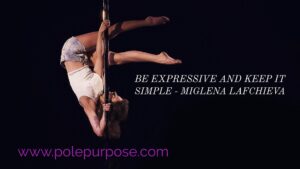 Miglena Lafchieva is an interface designer and a pole choreographer who is currently living in Berlin and teaching at Soul flight Studio. Throughout this interview Miglena speaks about her playful, childlike, creative process and how choreography has increased her understanding of music. Everything she speaks about, is echoed through her stunning dancing and detailed choreography.
Miglena Lafchieva is an interface designer and a pole choreographer who is currently living in Berlin and teaching at Soul flight Studio. Throughout this interview Miglena speaks about her playful, childlike, creative process and how choreography has increased her understanding of music. Everything she speaks about, is echoed through her stunning dancing and detailed choreography.
Tell us a bit about yourself
I was born and raised in Bulgaria. I moved to Germany to study 12 years ago, when I was 19. For the last 8 years I’ve been working as an interface designer in Berlin.
I used to do rhythmic gymnastics from the ages of 8-12 until I swapped sports for school, teenage parties and later on for university. I went to the gym for a few years but soon I got bored of regular machine exercises. Five years ago a friend of mine took me to my first ballet class where I found out that I have dancer’s legs but I no clue what to do with my arms. Soon afterwards, I discovered modern, lyrical and contemporary dance and I fell in love with it. A year later I started with pole dancing.
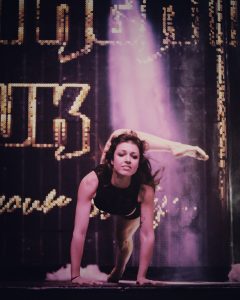 When did you choreograph your first piece of work?
When did you choreograph your first piece of work?
It was three years ago – a solo piece for the anniversary of Soul Flight, a Berlin based pole dance school, that I now teach at. Since then I’ve continued creating choreographies for the Pole Motion and Pole Flow classes at Soul Flight.
What tends to stimulate your creative thoughts?
I realized that I was most creative as a kid. And because I was quite a bored kid, I had to invent my own games and this really developed my creativeness and playfulness. Now, as an adult, I have two strategies to trigger this ability again. The first one is putting myself into a (fake) state of boredom – taking time off, remaining alone and getting my head free of thoughts and everyday tasks. Because when I feel a pressure of having to produce anything (awesome), I tend to get stuck.
When I feel like I am getting stuck, the second strategy comes in. In graphic design, as in dancing, most important is getting out and away from the “workplace” and doing or learning something new and unrelated to what you already know or different from what you usually do usually do. And again, I start looking for this light holiday feeling in the head that we used to have as kids and that makes you become curious for new experiences and sensations. Later on I go back to the project with a new idea or approach.
Personal side projects and experimentations also keep my brain going and make me stay creative and inventive.
How do you think your experience as a dancer/choreographer has informed your pole practice?
I do not consider myself a professional dancer/choreographer, but I do consider myself a passionate dancer, who is constantly learning. I put more importance on my dancing skills than on my acrobatic skills, because I find this the most challenging part and at the same time, the most expressive part. It simply gives me a greater satisfaction when the work is complete.
Through my dance experience my pole work has become more playful and liberating. I love combining styles and discovering new perceptions. I became much more aware of movements, breath, physical and emotional strength and expression. And of course, it also made it much more graceful and clean.
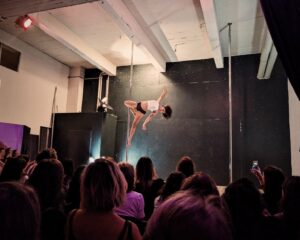 What is your favourite part of the creative process?
What is your favourite part of the creative process?
It is the fresh beginning, without any expectations of the end result. The exploring part is fun, as well as the initial flush of ideas. Also, the moment when you’ve been practising for a while and movements start to flow and become natural for the body.
What do you find most difficult about choreography and how do you overcome this?
As a choreographer – that each piece is individual and that there is no recipe for success. The process might go smooth and quick, or might become a frustrating stop and start affair. I then go back to the tricks I mentioned above to trigger my creativity.
As a dancer – when you get too technical and you don’t “feel” the dance anymore. Also when you don’t hear the music anymore, because you’ve listened to it too much. The latter bothers me again and again and I am still trying to figure out how to overcome this. @polepurpose: If I had to make a wish for a blog post, it will be this subject.
Who is your biggest inspiration and why?
My biggest inspirations are people who dare to create new forms of expression and combine styles. There are too many to mention, some of them probably less known. It’s people from different kind of fields – contemporary dance, circus, innovative performance arts, visuals, music.
For example, the people that participate in “Outbox me” – a dance battle that regularly takes place in Berlin. Recently I was lucky enough to meet and perform next to very talented young artists at the Berlin Circus Festival. The dedication of those people inspired me a lot.
I am also inspired by my dance teachers; Chaz Buzan, the choreographers and the dancers Zoi Tatopoulos, Yana Abraimova, Galya Peha, Lia Kim, Mitchell Jackson, company Marie Chouinard, collective Quixotic, collective Base Berlin. Just a few to name. Have a look at my Youtube playlists for more inspiration.
What, if any, do you think are the psychological benefits of creating your own work?
For me creativity means happiness. I found this explanation on the internet to be a quite good description of how I feel when I create my own work:
“Making things promotes psychological well-being. Process is important for happiness because when we make, repair or create things we feel vital and effective. (…) Functioning hands also foster a flow in the mind that leads to spontaneous joyful, creative thought.”
For a lot of people dancing their own choreography or freestyling could be easier than learning someone else’s choreography. It simply feels more natural and organic to dance the way you feel. This is also the only way to create your own style.
I like to combine both – taking classes, learning and performing someone else’s work and working on my own piece and performing it. Working on your own piece brings a greater joy and satisfaction though.
Pole Perfomance by Miglena, 2016 from Miglena Laf on Vimeo.
You sent us “Eclipse” as a favourite performance of yours; can you tell us how you prepared for this work and what your process was like?
After my participation at Pole Theatre UK, where I didn’t manage to breathe through the whole performance, I promised myself that my main focus would be on the breath from now on. So, “Eclipse” was all about breathing and feeling alive. As usual, all started with the music piece. To me, personally, the dynamics of this song indeed represent the dynamics of a breath – one smooth continuous loop, interrupted by slow, sensitive and frail parts, which sometimes feel like a silence.
The piece was originally created for Berlin Circus Festival, to be performed on x-stage. I decided to go for a spinning mode because of the smooth and repetitive melody. The continuous breathing parts basically feel to me like one long spin.
In this video I perform on a fixed spinning pole, but a big part was choreographed on x-stage. My advice is to always prepare on the same pole (or similar to the one) as the final performance. Because of the space, I also had different endings for both performances. One was in a big circus tent with a pole in the centre, the other one was a small stage with only little space around the pole.
My pole choreography consisted of moves that I recently learned in class, and luckily they matched very well to the theme and the music. The key to the performance was to set the length of the moves in relation to the music – some needed to be expanded and some needed to be shortened. The parts off the pole and also the low spins resulted from freestyling. Read more about my creative approach in the next question.
Do you have a particular creative method that you work from?
I have two approaches to start from and I usually combine both – music and freestyle. For me the music is at the beginning of everything. I start by researching its dynamics, layers and originality, and I aim to create moves that are accurately on point with its qualities. During the process I constantly ask myself one question – if a deaf person is looking at my dance, would they be be able to see and “hear” the accents, the tempo change and even maybe the instruments?
After I’ve examined the song, I’ll start a small experiment with improvising and grabbing those very first moves with my camera, before my mind starts worrying about look, execution and perfectionism. So many organic flows come from improvisation, only because you let go of expectations and images. Instead you just let the music and your personal feelings guide you. Then I examine the video, pick the best moves and work further with them, making them sharper and more expressive, while always double checking the music.
What comes first during your process, the pole or the floor movement?
I don’t have a rule regarding this. When I listen to a song, I sometimes get an inspiration for a floor movement, and sometimes for a pole sequence. Both are a good starting point. Just let your ideas flow and don’t bother with details at the beginning.
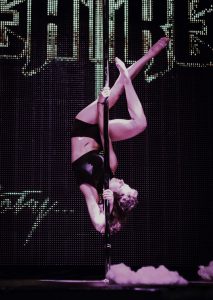 Since creating your first solo, how do you think you have grown as a choreographer?
Since creating your first solo, how do you think you have grown as a choreographer?
My first solo triggered something in me and I literally became addicted to the process of choreography. I haven’t stopped creating since then and I love every little piece I’ve created for my Pole Motion class. It has been a vital journey and I am very grateful for every moment of it.
I also started listening to music in a way that I have never listened to before. Suddenly I was able to “hear better”. I love the late night talks with my friends from the music industry. I feel like I was not able to understand and interpret music before I started choreographing myself. Every day I learn paying attention to artistic details and this is how I want to continue growing as a choreographer in the future.
If you could give readers a piece of advice for creating their dance, what would it be?
Be expressive and keep it simple!
In order to reach this, become clear in your intentions and feelings. Ask yourself what do you feel in each movement and why, and then really mean it when you dance or perform it. Even if you are creating something that just has to look beautiful, invent a meaning or a feeling that you can personally relate to, in this moment and in this place. Then it will look better, because you will become more expressive.
Do less but do it better! This is particularly true for pole dancers. Give the audience the chance to enjoy every move. This doesn’t mean to simply stay longer in poses and not to move for seconds, but to avoid making shortcuts and cutting moves. If you follow this rule, you will realize that you need double the time for a combination… or that you can simply do the half of it. Leaving things out is no loss, but a win! Personally, I love the beauty of simplicity.
If you were hiring a dancer to perform your work, what would you look for in them?
A dancer that can put a personal meaning into the piece. It doesn’t have to be same meaning I put into it originally, as long as it is real, vivid and tangible.
What sort of time frame do you give yourself to create a new piece of work?
It depends on your expectations and goals. I’ve created and performed choreographies in a week, and they turned out more successful than my choreography for Pole Theatre UK, for example, for which I had almost 5 months time to prepare. So, it is not that much about the time, but more about your expectations and your state of mind in the current moment. Still, I prefer not to feel any time pressure, since this is not stimulating my creativity. As I mentioned before, I like to put myself in a state of boredom and playfulness, so a minimum of two weeks is required. Give yourself more time, so you can regularly take a step back and come back to it again with an objective perception.
Finally, what does pole dance do for you?
Pole dance allows me to express myself. It also made me believe that I am capable of much more than I think I am.
You can find the talented Miglena on Facebook, Instagram, Vimeo and YouTube.
If you enjoy reading about the process of pole dance choreography, check out Speaking through Movement and keep up to date with Pole Purpose by following us on Instagram and Twitter.



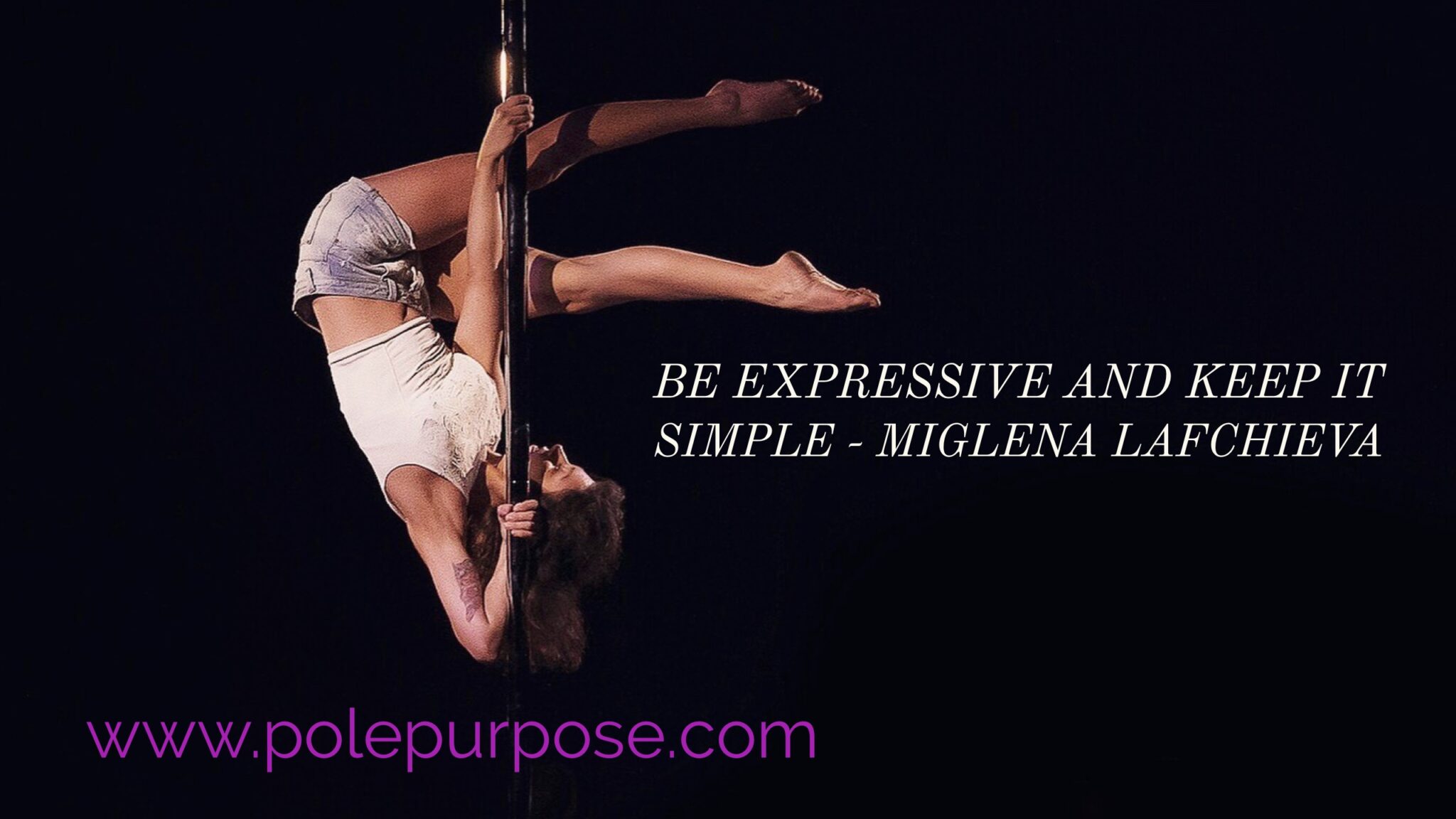
No Comments